Bits and Braces
For more information on brace and bit, see our beginner site Common Woodworking.
I took another exploration into my Essential Woodworking Hand Tools book to look at the boring things of woodworking. I know, it should be belts and braces but I’m more talking about a safe practice than risk aversion. Brace and bit woodworking is a safe way to bore holes. It works at your speed and none of the energy becomes wasted. Of course there are disadvantages too. It takes both hands to hold the brace and so there is no free hand to hold the workpiece. Another thing is the swing of the brace as you rotate the handle to drive the bit into and through the wood, a good ten inches. Internal corners in tight spaces are hard to negotiate even if the brace mechanism does have a ratchet for forward, lock off or reverse actions. But it is all too easy just to reach for the drill-driver and that means the total abandonment of another tool that still has truly practical options for us to work wood with. All I am saying is for adult woodworkers with all their faculties there is a place for both. My worry is that 99% of woodworkers do not know that the brace and bit are well proven methods of work and that they were not necessarily replaced by something better or even more advanced. This is especially important where total control is essential and an overactive trigger finger might cost the work in progress. Drill-drivers wear out the component bit tips at a rapid rate: that’s twist drills, pozis and so on, a hundred times faster than when relying just on your manpowered alternatives. One badly aligned drill-driver often ruins a pozi tip in a single spin off-piste – even in experienced hands.
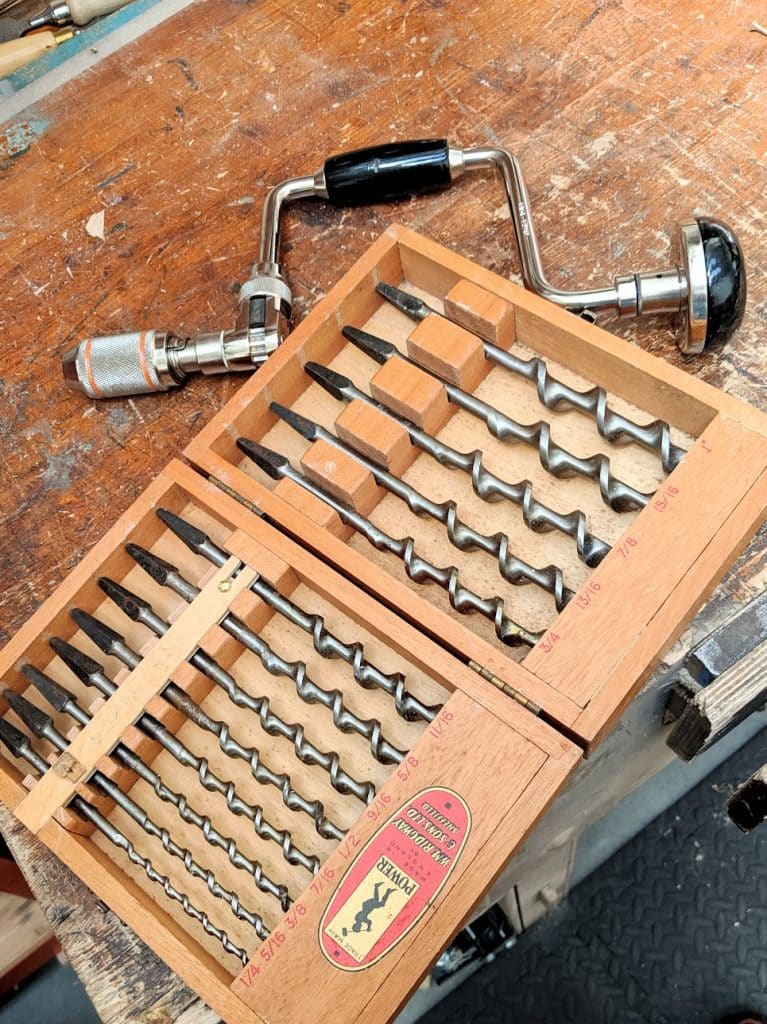
I know what most people think about the brace and bit: outdated, old fashioned, why use one? Slow, inefficient, hard work and so on. Of course none of that’s really true at all. The brace and bit is just less suited to modern-world workers in all categories of work where users have no longer been taught even how to sharpen a pencil let alone how to sharpen and maintain cutting edges to tools of this type; of course they are living worklife on the conveyor belt – mostly they have little option. But, think of it this way where in my world I grew up using the brace and bits most days. They needed sharpening every few days so I not only gained those skills but understood the essentiality of such actions. My work wasn’t just to beat holes through stud walls but to create crisp clean holes with unflawed rims. Sharpness is always critical to fine work. Trades rarely comprise the fine work demanded by artisans in craft in the same way. They operate completely differently and that’s in general is just the way it is. There were of course electric drills in my early days starting out. Mostly they had poor ergonomics and developed better ones over the ensuing decades. I doubt most electricians would get by with a brace and bit and a saws-all of some type these days but back in the day, before battery driven drill drivers, they worked better as the original cordless equipment, even for them. But mostly their needs are not the needs of the artisan. Mostly they are assemblers of component parts, same with plumbers, where bolt on wires and threaded connectors unite tubes to connect water or wires from source to supply, just not in a factory setting. In my work the brace and bit is irreplaceable for several reasons and not the least of which has been the safety in work they provide. Somehow they slow down my world to a workable rate within an acceptable pace best suited to my humanity. It’s more the feed rate that matches my humanity that I always try to look for. I feel always in control. I’m always concerned about any possible damage to my workpiece and that mostly revolves around slippage, out-breakage, excessive energies resulting in damage and so on. I’m not mesmerised by speed and I hate the fact that a drill running a 3/16″ bit through a 1″ section of wood takes 2,000 revolutions when my hands turning a brace takes no more than 20. You pay for that. One way or another you pay for it. Of course boring holes for wires in 2×4 stud wall is of no consequence. A high speed auger bit does that well, but in other situations, in furniture making, I’m never really in a hurry.
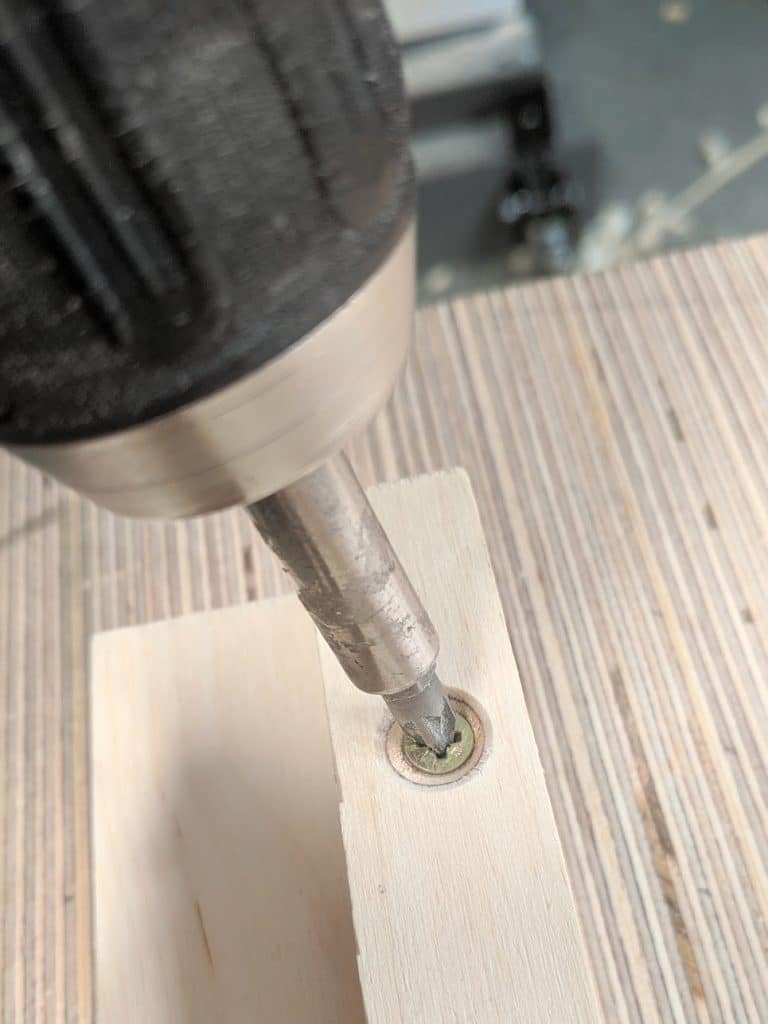
A drill driver can and does go through drive bits in a heartbeat. That’s why they sell them in packs of 20. A misaligned bit in the hardened pozi-drive screw knocks the corners off the bit in seconds, possibly unusable after the first use if badly really badly used or loosely held.
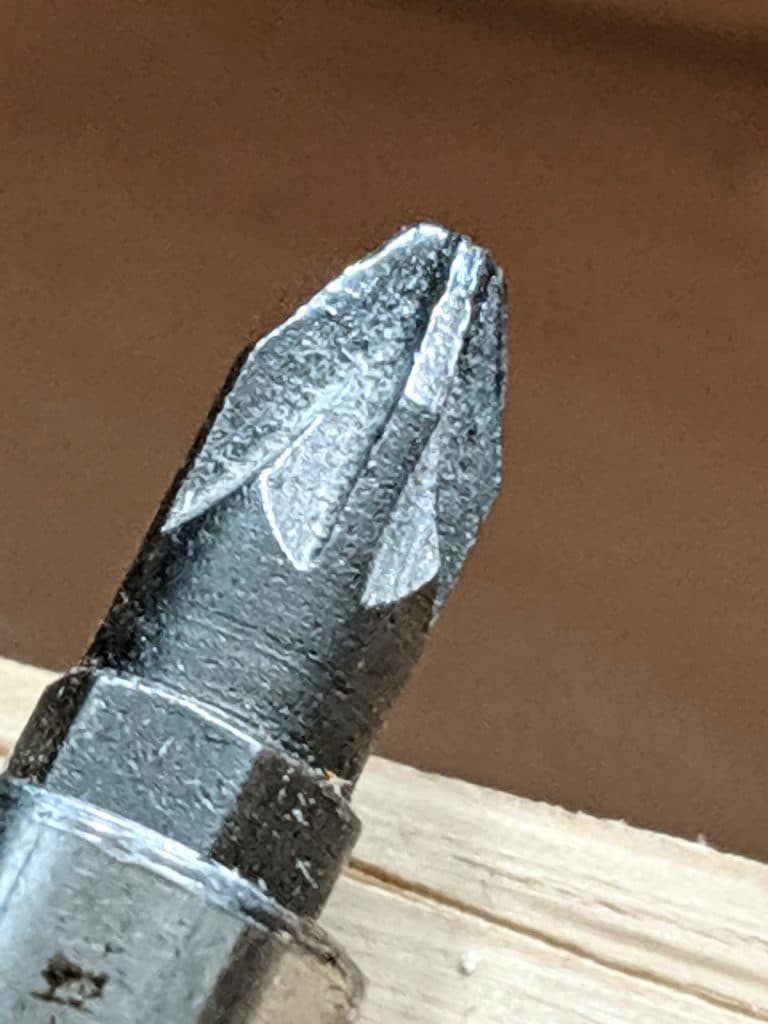
Anyway, I thought it was worth trying to see what the difference was between a drill driver at 1500 rpm and a swing brace at manpowered rate. It took 4.5 seconds to drill through 1″ of oak with a 1/8″ twist drill using a drill driver. It took 10 seconds and 19 revolutions with the brace using the same bit to do the same. So twice as long with the vintage brace and twist drill but but only one fifth the revolutions. Now for a 3/4″ hole in pine using the brace and bit it took 8 seconds and 21 revolutions – very quick, I thought. With a powered 3/4″ Forstner bit in a drill-driver it took 12 seconds for the same sized hole set on 1,500 rpm so took many more revolutions for the same sized hole and half as long. Anyway, I thought that the difference was not so great as I thought it might be. Of course we’re not comparing apples for apples in that case but it was still interesting.
One thing I enjoy most about the conventional swing brace with its forward/reverse ratchetability and its auger bits, and it’s a part that people seldom see or at least consider, is that with each hand turned revolution the bit achieves a controlled and measured depth of cut. This governance is in accord with the thread on the spiralled snail point. This snail pulls the bit ever deeper into the wood so we have the perfect controlled feed rate according to our human speed. On power-drill auger bits nothing of this synchrony takes place. You have 1,500 revolutions per minute with a threaded snail that does indeed pull but with not synchrony at all. Its the sledge hammer and nut scenario where the bit blasts through the wood uncontrollably ripping away in the hands of the macho-man. Such a wretched invasion of the workplace.
Let’s look at my bits. The snail threads are uniformly even at 1/16″ increments.
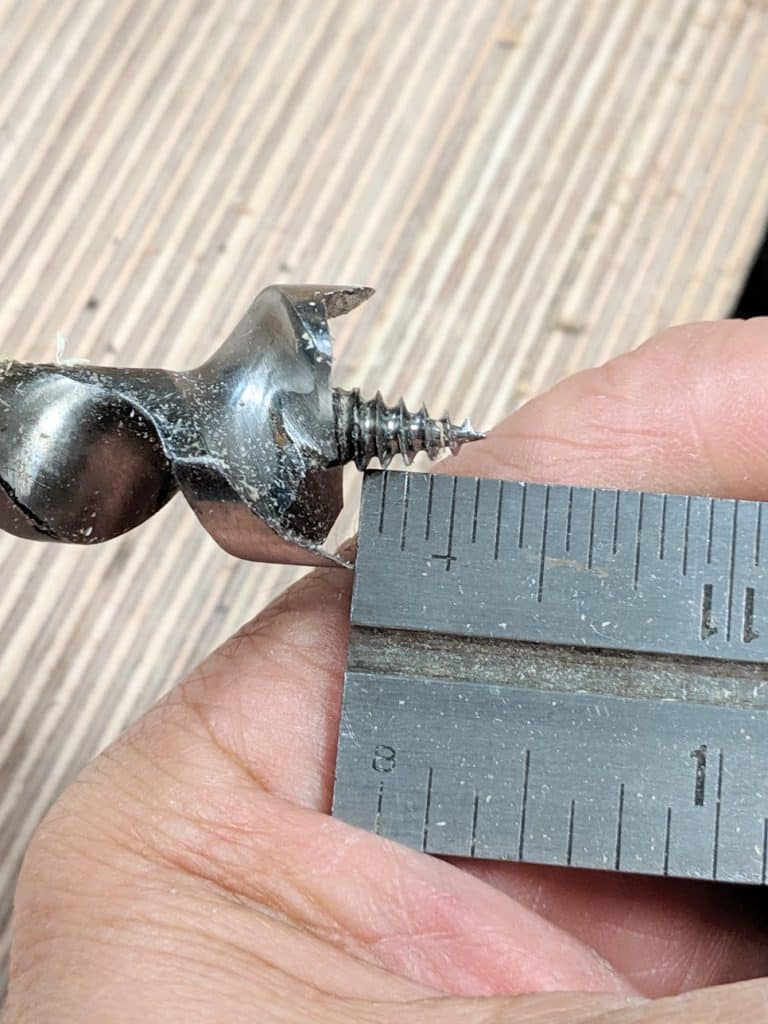
This reality governs the feed rate at 1/16″ depth per one revolution. In this case , from the point hitting the wood, it takes 6 revolutions before the outer wings cut the rim of the hole.
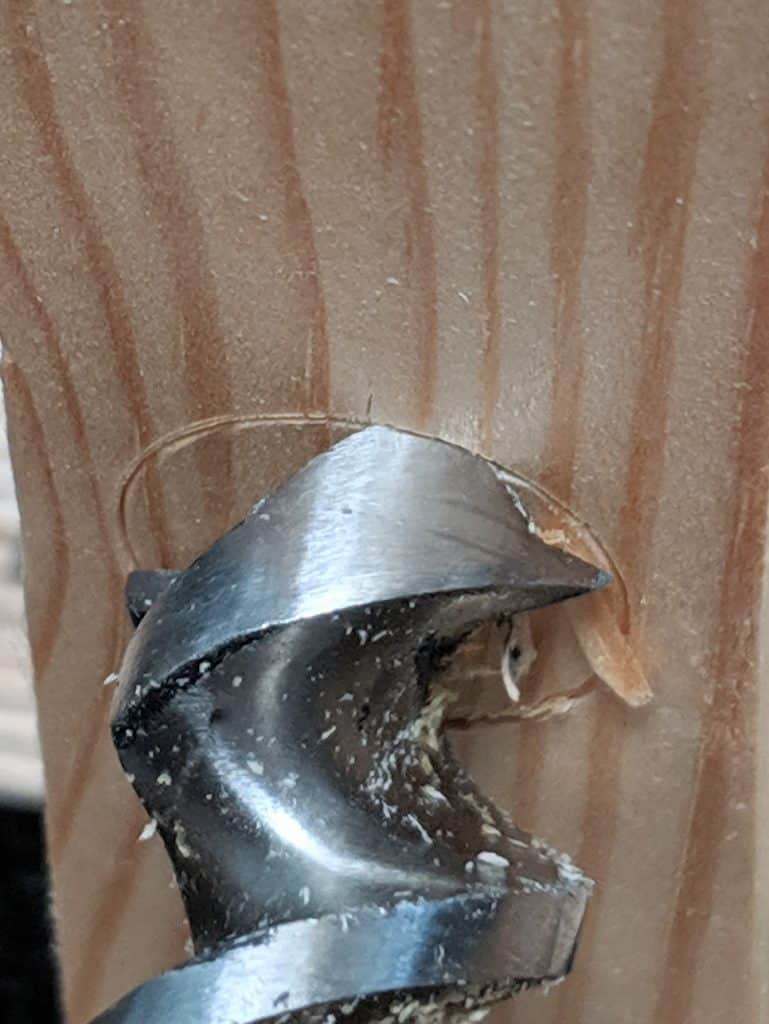
I make one revolution and the whole rim of the hole develops the circular equivalent of a knifewall circumference. Lovely!
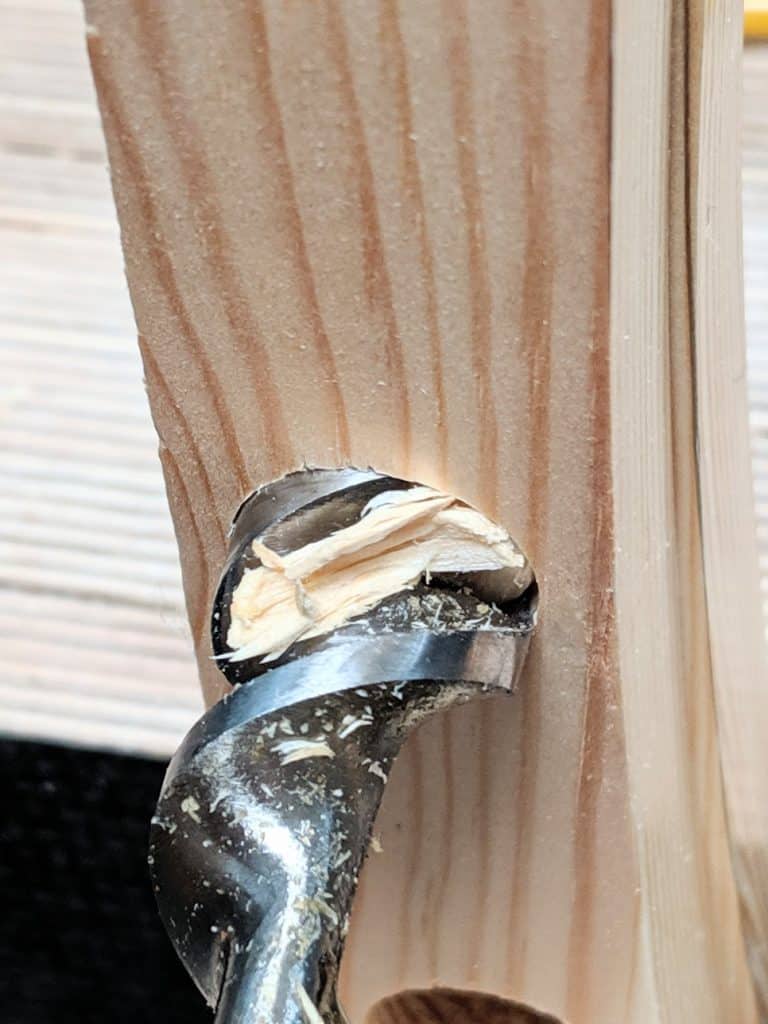
Once this rim-cut is done, subsequent revolutions engage the raker cutters between the outer spurs and the conical threaded point to bore the 3/4″ hole. I took a total of 17 revolutions to pass through the stock that was over 3/4″ by 1/16″. This starts once I’ve cut the rim so the rest to excavate through to the other side. That means that each revolution deepens the cut at a specific cut rate, give or take, of 1/16″ of an inch.
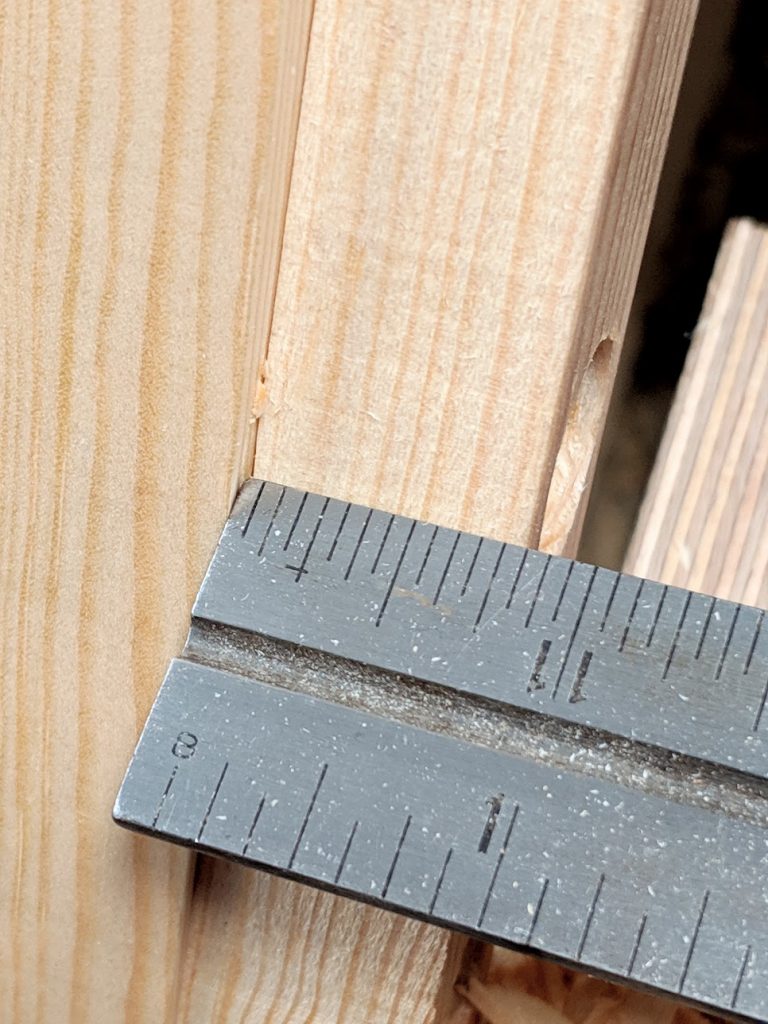
My depth of cut is therefore countable. A half inch depth starts when the rakers engage the wood surface and 8 full revolutions takes me to depth.


Outstanding analysis of this tool set. I will start using to replace
the portable electric drill.
Thank you.
Jim Childress
Willow Grove, PA 19090
Since few people use the bits there are very nice sets available on ebay for less than $100. What Paul glosses over is the amount of effort often needed to use these babies. I am building a table of maple and recently used the bits instead of a drill press to clean material for rather large mortices. I cannot tell you folks how quickly I felt my age. Lean, push and turn is great in 3/4″ white pine but not in 8/4 maple. But they do work and in the end you tend to sleep well with less wood dust in the air.
Martin, You should sharpen your bits, mine go easily through maple or oak .
I have Jennings bits
I agree Martin, the physical effort with these is intense. Best suited for the young and the strong, not the old and the wealthy (the latter of whom consistently outbid me on ebay, despite that I am probably older than they.)
Do you maintain different sets of bits with different thread pitches for hardwoods versus softwoods?
I find that good quality vintage bits are difficult to come by these days, at least in the US/ebay. Also manufacturers like Irwin produce new bits that have a terrible fit and finish. The snail is mangled or filled with the leftover metal from the machining process – the smaller bits are near impossible to fix, because of the cutters being in the way of a file. Does anyone produce perfectly manufactured new bits anymore? I’ve tried old and new without much success. Unfortunately I don’t have time to be a professional antique hunter to take years to assemble a mismatched set 🙁
Regardless, thanks for the post! I definitely want to get the most out of what I have 🙂
Tools for woodworking sells new Jennings pattern bits that look very nice and well made. I’ve not tried them because they are pricey at $40 or more per bit.
Jim Bode always has nice vintage sets available for $100 – $200 USD. I’ve had good luck myself on ebay. Picked up a practically unused set of vintage Irwin bits for $125 USD (only one bit looked like it had been used even once). I picked up an almost as nice set of vintage Irwin’s for $80 USD. I’ve gotten better prices for other bits on eBay but the quality was worse – more used and beat up. I bought a set (ebay again) with moderate wear that was stamped with the name of a cemetery for $39 because it was interesting. My experience with eBay is that if you are really patient or lucky or both you can find great sets for great prices. If you are less patient you can get nice sets on eBay quickly for $125 or more. For that price range you can get even faster gratification on the Jim Bode site. If you have $500 or so burning a hole in your pocket you can go with something new and boutique like on the tools for woodworking site.
Wood Owl bits work very well. They have a heaxagonal shank so they might not work in all braces. My particular Stanley brace holds them perfectly.
Thanks for the tip, Ken!
I have Wood Owl bits, but they don’t get gripped well in my brace’s jaws (2-part alligator type). Ken, is your brace’s jaw the 3-piece kind?
I have a Bell System brace made by Stanley. It does have a two jaw chuck with v’s in the jaws. I’ve drilled an 1 1/4 “ holes, through hard maple, with it and the Wood Owl bit with no problems.
My father wired homes in the evenings and weekends in the up until the early 1980s ( he was a linesman by day) and he used my brother and myself as helpers. He didn’t get an electric drill until about 1969. The brace and bit served even after he got the electric ( new homes often had no power until very late in their construction, and portable generators were simply not to be found). He also used it during the workday for mounting crossarms , transformers, and other hardware. Funny thing, we never saw boring holes as a chore- no different than using a hammer. I count myself lucky, I saw the old school and worked in the trade for many years, and now today I see these young guys who cannot build without power tools, when I was young they were a luxury.
I bought a brace and bites off of eBay last year, after you wrote about them. I have used them more often than I thought that I would. Nice to have a change from power tools.
I acquired my brace over 30 years ago and it was ‘Old’ then. I only had four bits at that time and they were not in the best condition. Not until recently have I learnt to sharpen them (thanks to Paul). I did buy a set of bits about two years ago but alas cheap poor quality steel and definitely not up to the task of cutting consistent clean holes. I will keep looking for some ‘Old’ sets (Australia)
Slightly off topic but here goes. I noticed you used a pozi drive screw above. I have used them and also many other types. My favourite by far is the Robertson. I am from Canada and it is popular here. I know it is difficult to find in the States but what about Europe? It works so much better than the other bits. Drivers are colour coded and numbered for different sizes, it positively connects with the screw thereby negating fear of your work being damaged and the bit rarely becomes damaged, plus being just easier to use. Is it even available outside Canada?
They are available here in the UK but not as available as pozidrives. I have used them but they also look more like production product than pozis so they are not for fine work as is the case for the better high end product. Slot heads cannot be beaten for a quality look but they don’t work particularly well with any kind of driver and they do slip with even the slightest misalignment. but you cannot get away from it, a slotted brass screw in a drawn brass hinge is still beautiful.
I’ve actually been using the torx drive screws. They seem to have fewer problems with damaging bits than the pozi or Robertson(also available in the us). Don’t know if it’s true or not but an aircraft mechanic friend said torx was developed for high torque applications.
they also look beautiful, even better than slotted ones. Don’t know if there exists brass torx head screws, though.
Robertson bits and screws are readily available in the usa. More popular are Phillips and Star or Torx drive, which I consider more secure than Robertson ,and they can be had color coded. but you really have to stock yourself with all three to get through say, a house construction and interior fitout. Pozidriv and Supadriv are making inroads. Stuff that shows usually got slot head screws (predrilled and clocked, of course).
Also, it seems each time you go to a store to get more trim screws, they have changed the type they stock so often you switch halfway through a job.
Philips screws were designed for the auto industry assembly line to pop out under high torque so they didn´
t break the screws off . It’s also what makes them so frustrating. They are also unfortunate in that they are at first glance a lot like Cross, Frearson, Pozidriv, Supadriv, French recess, JI S B 1012, and Mortorq. The boating industry, for instance, seems to gravitate to Frearson. Get the wrong tip and you mess up the head.
And the tool we mostly drove screws with before reliable portable power was the large “heavy pattern” Yankee spiral screw driver . Every craftsman had one in his box. My North Brothers 31A is finishing out its second career and still works as well as when it was new in the 1930s – try doing that with your Delta. And you can still get hex adapters for it, so you aren’t restricted to the three bits that came with it and probably lost.
And in an ironic twist, Yankees are now German made and come with a 1/4” hex chuck stock. They unfortunately only make the smaller sizes. The heavy pattern 31 series is a thrift store hunt if you want one. I don’t feel you get enough torque with the smaller models.
If you bought a model with the return spring in it, the shop foreman made you take it out. They were safer that way and it forced you to keep one hand near the tip so there were fewer slips. I spent yesterday driving slotted screws in some furniture I was refinishing . No slips.
On Phillips drive…Sorry to correct you, Larry. I’d also heard of this, but it’s not true. From Wikipedia on Phillips drive – “There has long been a popular belief that this was actually a deliberate feature of the design, for the purpose of assembling aluminium aircraft without overtightening the fasteners.[15]:85[16] Extensive evidence is lacking for this specific narrative, and the feature is not mentioned in the original patents.”
https://en.wikipedia.org/wiki/List_of_screw_drives#Phillips
Hi Paul and team
I have been able to get some good brace and bits from flea markets in Canada, but you have to know what too look for. I got a brace and some Russell Jennings bits a few years ago. I also have some old Irwin bits from a hardware store in Ontario. In the store it was like stepping back into the 50’s time period. It was well known for having bits.
I have to chuckle a bit because I watch people trying to put in deck screws and they have the drill driver going for a little while and then the cussing starts. I watched somebody struggle with a 3” screw and their hand cramped up using the screwdriver. I felt bad for them and I have an adapter from lee valley that goes into my brace chuck and I can use like a screwdriver. I helped the guy out by driving about 10 screws in while his hand uncramped. He was in awe of what I had used and was seeking to buy one when I left.
If you can use your brace as a screwdriver like I can, if the screw head starts to strip out like in Paul’s blog use valve grinding compound. You can find it in automotive stores. It’s a bit like grease but it has fine grit in it to grind the valves in your car engine. I put a bit on the tip of the screwdriver bit and it allows it to grab the screw head and help you drive the screw-in without stripping the head of the screw.
This is tip my dad has taught me while I was in my teens and I find it very handy to use it when the job starts to get obnoxious and wants to fight.
Doug, please tell us more about the adapter. I have regular brace shank screwdriver bits in flat and phillips but with size limits. Does the adapter allow you to use twist bits? Others?
Hi Bob. The adapters can be found here:
http://www.leevalley.com/en/wood/page.aspx?p=32300&cat=1,180,42337,32300
These adapters are not currently available. Too bad, as I could use one. My cordless drills are all muscle powered, no batteries.
If you can get a common quick-change Hex Bit Adapter or Yankee Adapter to fit your particular brace (I ground mine), your options are limitless; socket wrenches, twist drills, countersink, and all the screwdriver tips you could want.
My 1/2hp Craftsman hammer drill will split the end of a board (torx drive in deck boards) so quick . I started running the end screws down to about a 1/4 inch sticking out and finish it perfectly with the brace.
A very timely post Paul. Last Thursday a friend of mine gave me a wooden box of Millers Falls bits all 13 of them. They were in very good condition but some had rust, two were bent, the #5 had its wings bent inwards. I assume it had hit a sunken nail or screw. I’ve cleaned them all, refurbished the box and will now sharpen the bits. There was also a countersink bit and an expansive bit but I’m having trouble with that as it is pulled in by the snail and scribes a clean circumference then the centre section bottoms out and waste removal ceases as the snail thread strips out.
I assume the geometry is wrong and would welcome any advice on getting it to cut correctly.
I was lucky enough to have a Dad who was a basement shop tinkerer. He had a couple of braces and sets of bits. When I was big enough to ‘tinker’ with him – about age 5 – he would set a bit and give me the brace and a scrap or 2 of wood. I worked at it for hours. Great memories!
I have several braces and a couple of complete sets of auger bits along with countersinks and adjustables. I use them quite often. Once I had a handyman friend helping to install and wire a light fixture under the eaves. The battery on his power drill died and he had not spare with him. I got the brace out with proper bit and showed him how to use it. He was gobsmacked. I think he now has at least one brace and hunts for bits at fleas and yard sales.
You can focus on the quality of the finished product, the speed to achieve that result, the physical effort required, the skills required, etc. There is no one correct way for me, but experimenting using different tools seems worthwhile.
A full blog about brace and bits? BORING!
Yup! And I suppose there’s a twist to it in that you’ll never see the point in it.
I have 3 braces and 2 complete sets of bits and a bunch of screw driver bits and counter sinks for the brace. I drill all my holes largest than 3/8″ with a brace.
It’s a great tool and if you don’t have one your missing out.
Thank you.
Bits may be boring, but I spent some time with some of them recently, and…brace yourselves…I also found them much better for cutting large holes in wood than their electrical counterparts.
I could go on, but suffice to say that with a reverse drilling start, I cut a clean 1 inch wide hole in a piece of thick expensive wood with a bit and brace in ten minutes, whereas ten years ago I drilled a frayed, off center 1 inch mess in a built-in cabinet in only one minute (after I recharged my two battery powered drills overnight), with dust filling the living-room and tear-out on both sides (luckily in the very back of the console so it did not affect our real estate values).
I found my first brace in a rubbish bin by the side of the road. I was young from a large family and somewhat poor. I learned to love that thing. The precision I could achieve by drilling a tiny pilot hole with my old push drill for the auger bit snail to follow was a revelation. Why be in a hurry? My grand dad always asked why is there often not enough time to do a job well, but always enough time to do it again.
After burning up a couple of hammer drills, I have come to rely on a brace fror boring large holes in pressure treated lumber, especially landscape timbers and large studs like 4X4s. A spade bit wreaks havoc on a drill, especially a cordless one, regardless of how much torque it produces. I have found it far easier to wax or oil the end of a bit and crank away with my brace. As an added bonus, the holes are generally clean if my bit is sharp and I have had less issues with wood splitting, but sometimes pilot holes are necessary. For REALLY big jobs, I bought a North Bros. 12″ brace on eBay for $40 and it can go through virtually anything. I also find that the effort is comparable to a powered drill or even less. I do wish somebody would produce a high quality brace and bits again though. The greats like Lie-Nielsen and Lee valley seem to be uninterested. I haven’t had any experience with the French made brace Lee Valley offers, but it seems decent. Nice article/update on boring though. Braces are one of my favorite tools.
As with almost all tools, there really is no shortage. The advent of eBay has ensured that hand tools will forever cycle through and especially so here in the UK and the USA. On a given day there will be 30 braces offered, far more than demand.I have undeniable success ever since using eBay as a primary resource and tools that came only through dealers prior to the advent of eBay served only to keep prices high. Now, there is no longer any need for acquiring through dealers and the prices are really quite fair. I say that because we really no longer need to make what already exists and the premium makers know this.
Nice article !
Paul, can you suggest some process to shape water pipes(metal)?
Thanks,
Andrew
“This set with the new old-stock Stanley brace cost me £48 on eBay and to me it is worth four to six times that easily.”
Whenever Paul buys something on eBay, he goes straight online to show what a bargain he’s got. How he’d happily have paid two, three, four times that for his Sorby plane, Groves saw, Auger bits…
How do you think that makes the seller feel? Isn’t it enough that you got the tool you wanted, for the price you paid? What do you imagine this does to prices for similar items? This is the ‘Paul Sellers effect’.
Ridicule the seller, gloat online, watch everyone else pay 3x more.
I guess Paul outsmarted everyone, and won the day.
I think that once again the point is missed here and there is no need for cynicism. Just showing others that things can be had for a very fair price via eBay, that it is indeed well proven as one of the fairest places to look for what might not be had from any other source and the best thing is indeed to keep your eyes open to the likelihood that what you are searching for will come in at the right price for you. Just a win win for all really, Dave. For some people they just want to clear a space in the garage, others want to make some money and for others they just want to see something benefit someone else. Giving my tools to others, apprentices, friends, students and then those `i never know or met has always been my greatest delight.
Speaking of. There is currently a Bell Brace on eBay right now for $8 USD plus shipping. No visible rust according the pictures. The deals a truly to be had, you just have to search for them.
I have a decent brace, but no proper auger bits to go with it. I need to fix that. But I just haven’t had the time or patience to wrestle with eBay over tools recently. I’m actually willing to consider buying new if I can narrow it down to a small number of specific sizes rather than getting a larger set…
If you opt for METRIC Augers, the holes you bore will accommodate metric bolts, metric piping, and metric dowels, without any sloppiness. You’ll also find it easier to source a range of metric plug-cutters, for the smaller holes.
Consider the different types carefully. Some are short cutters on a long shaft (which tend to wander), some have a thin spiral, and others have really deep spirals for better accuracy.
The newer types also have improved (hex) shanks, which give better torque without slipping in the chuck.n
My favourite purchase was a flat screwdriver bit. Great for those stubborn painted-in and rusted door hinges.